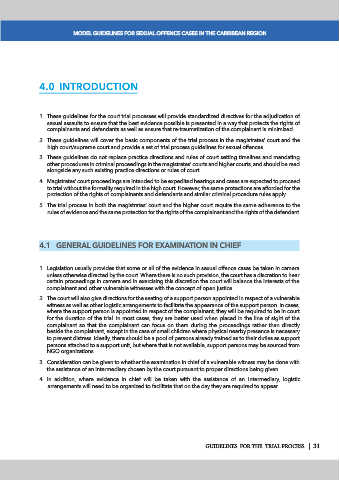Page 630 - Magistrates Conference 2019
P. 630
MODEL GUIDELINES FOR SEXUAL OFFENCE CASES IN THE CARIBBEAN REGION
4.0 INTRODUCTION
1. These guidelines for the court trial processes will provide standardized directives for the adjudication of
sexual assaults to ensure that the best evidence possible is presented in a way that protects the rights of
complainants and defendants as well as ensure that re-traumatization of the complainant is minimized.
2. These guidelines will cover the basic components of the trial process in the magistrates’ court and the
high court/supreme court and provide a set of trial process guidelines for sexual offences.
3. These guidelines do not replace practice directions and rules of court setting timelines and mandating
other procedures in criminal proceedings in the magistrates’ courts and higher courts, and should be read
alongside any such existing practice directions or rules of court.
4. Magistrates’ court proceedings are intended to be expedited hearings and cases are expected to proceed
to trial without the formality required in the high court. However, the same protections are afforded for the
protection of the rights of complainants and defendants and similar criminal procedure rules apply.
5. The trial process in both the magistrates’ court and the higher court require the same adherence to the
rules of evidence and the same protection for the rights of the complainant and the rights of the defendant.
4.1 GENERAL GUIDELINES FOR EXAMINATION IN CHIEF
1. Legislation usually provides that some or all of the evidence in sexual offence cases be taken in camera
unless otherwise directed by the court. Where there is no such provision, the court has a discretion to hear
certain proceedings in camera and in exercising this discretion the court will balance the interests of the
complainant and other vulnerable witnesses with the concept of open justice.
2. The court will also give directions for the seating of a support person appointed in respect of a vulnerable
witness as well as other logistic arrangements to facilitate the appearance of the support person. In cases,
where the support person is appointed in respect of the complainant, they will be required to be in court
for the duration of the trial. In most cases, they are better used when placed in the line of sight of the
complainant so that the complainant can focus on them during the proceedings rather than directly
beside the complainant, except in the case of small children where physical nearby presence is necessary
to prevent distress. Ideally, there should be a pool of persons already trained as to their duties as support
persons attached to a support unit, but where that is not available, support persons may be sourced from
NGO organizations.
3. Consideration can be given to whether the examination in chief of a vulnerable witness may be done with
the assistance of an intermediary chosen by the court pursuant to proper directions being given.
4. In addition, where evidence in chief will be taken with the assistance of an intermediary, logistic
arrangements will need to be organized to facilitate that on the day they are required to appear.
GUIDELINES FOR THE TRIAL PROCESS | 31

